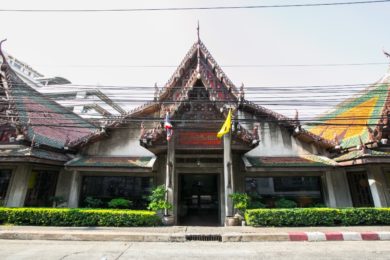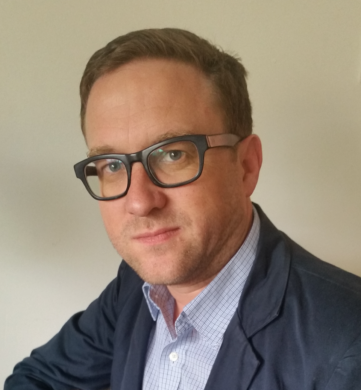Bangrak High Street
Back in middle of the 19th century, as Bangkok was receiving migrants from China and Europe, King Rama 4 (1851-1868) declared that the Chinese should halt their spread from Rattanakosin south at Talad Noi, where River City sits today, and that Europeans would be allowed settle in Bangrak. The Europeans, so as to allow them to move around in the manner they had been accustomed, requested a road be laid – the first road in Bangkok
 Over the years, Charoenkrung Road became a busy transit route, a passage for people and cargo from the docks in Yannawa and Bangrak up through Yaowarat to the capital in Rattanakosin. At the turn of the century, trams were introduced, travelling a parallel path to the river barges and tall ships.
Over the years, Charoenkrung Road became a busy transit route, a passage for people and cargo from the docks in Yannawa and Bangrak up through Yaowarat to the capital in Rattanakosin. At the turn of the century, trams were introduced, travelling a parallel path to the river barges and tall ships.
Soon, European style villas where built on the Bangrak riverside. Number 1 Captain Bush Lane, the residence of Anna Leonowens, was the first villa to have a postal address. Opposite it, on what is now The Royal Orchid Sheraton, was the first office of the Hong Kong and Shanghai Bank (HSBC). The Portuguese Embassy was built next door in 1880 on land gifted from the King. Further downstream, the French, Dutch and British Embassies were all also established.
King Rama IV built the Customs House, with his State Rooms on the upper floor to greet visiting diplomats and traders. The Dutch East Asiatic Trading Company’s building still sits adjacent to the grande dame of hotels, The Mandarin Oriental.
On either side of Charoenkrung Road, shophouses filled with traders, eateries and travellers. Bangrak became the bustling centre for trade. Considered to be one of Bangkok’s oldest commercial districts due to its riverfront location, it became the main water transportation hub, bringing together multiple cultures, languages and religions into the growing city of Bangkok. Intertwining Eastern and Western cultures, lifestyles and architecture into a single location, all this gave Charoenkrung Road a unique identity, interesting, vibrant and valuable in terms of history, economy and society.
Changing times
With the post World War II boom, Bangkok spread east, first to Silom and Siam, then Sathorn and Sukhumvit. The next generation of Talad Noi and Bangrak moved to the newer suburbs, leaving their parents behind. Luckily the development of new areas of Bangkok meant the riverside districts have been largely untouched. You can still find beautiful villas and traditional shophouses along the narrow sois that join Charoengkrung Road.
In 2013 and again in 2015, Thammasat University’s Urban Planning Faculty carried out a study in the Bangrak area. Painstakingly, they mapped each and every property, categorising the tenants of each. Home, restaurant, retail shop, jewellery maker, office, and so on – all were identified. They found that 23% of the properties in the Bangrak district were vacant; un-let and unused. One year ago, soon after the most recent Thammasat study, a small group of people came together as the Creative District. It was truly a lucky convergence of circumstance and like-minds.
Establishing themselves as the Creative District Foundation, the group now has some twenty initiatives that are now being worked on, grouped into six tracks: art, design/digital, buildings, urban planning, food and community.
Among the initiatives are: BUKRUKK urban art festival, that was held in January this year; The Charoenkrung Gallery hop takes place in a dozen or more art galleries every six weeks. At the same time, there’s an ambitious environmental programme planned. At the north of Bangrak funky bars, galleries and another warehouse development similar to The Jam Factory are all being established.
To prepare for their move from Emporium to the Grand Postal Building, the Thailand Creative and Design Centre (TCDC) has conceived Co-Create Charoenkrung in collaboration with Thai Health Promotion Foundation (ThaiHealth). The vision is that Charoenkrung become a creative hub, driving the economy and enriching the social fabric of the district.
 But such projects are a delicate balance. How do you revitalise old Bangkok without damaging the authenticity of the area, and without gentrification changing the social fabric beyond recognition, and without losing the beautiful old buildings? The answer just may lie in Australia.
But such projects are a delicate balance. How do you revitalise old Bangkok without damaging the authenticity of the area, and without gentrification changing the social fabric beyond recognition, and without losing the beautiful old buildings? The answer just may lie in Australia.
The man from Newcastle
In 2008, Marcus Westbury returned from Melbourne to open a bar in his hometown of Newcastle, in New South Wales, following a success as a festival director in Australia’s arts capital. To his shock, he found what was once a thriving high street, linking the ports with the suburbs, sitting lifeless. A ghost town where there were once department stores, retailers, offices and theatres.
What followed was an audacious and ingenious project to resuscitate the shopping precinct. Today Newcastle’s high street is bustling once more, but this time with artisans and craftsmen, and internet start-ups selling their wares to buyers across Australia, and around the world.
Australia’s Prime Minister, Malcolm Turnbull, referred to Westbury as “the brains behind the highly successful ‘Renew Newcastle’ project, which used the ideas and imaginations of the city’s residents to revitalise the city’s abandoned CBD.”
Westbury says: “The key point for me is that high streets and creative precincts have to differentiate themselves from the generic shopping mall experience. Malls are essentially about getting the same things you can get anywhere. Creative places need to be built around unique things and experiences you cannot get anywhere else. Renew Newcastle has worked because it has put a premium on distinctive and unique experiences rather than trying to turn the city back into the shopping strip it used to be.“
————————————————————————————————————————————–
In collaboration with the Australian Embassy, The Royal Orchid Sheraton and River City, present:
CREATING CITIES: Co-create Charoenkrung
Marcus Westbury shares his story of resuscitating the downtown shopping precinct of Newcastle, the Australian city in New South Wales.
Local heroes Dr Peeradorn Kaewlai and Yossapon Boonsom will join the afternoon presentation, providing and insight as to how Bangrak and Klongsan are being turned into Bangkok’s Creative District.
For more information visit www.bangkokriver.com
CREATING CITIES: Co-create Charoenkrung
14:30 – 17:30 Tuesday 17 May
River City Bangkok
Attendance is free of charge

